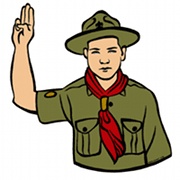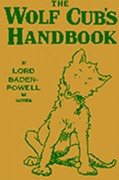Cub Scouts - a brief history

When Baden-Powell created the Scout Movement in 1908, it was designed as a programme for boys over the age of eleven. Very soon younger brothers wanted to join too, so in 1916, he published outlines for a scheme open to younger boys, it was to be called Wolf Cubbing.
The choice of the name Wolf Cubs suggested to him the ideas of Cub Packs, and to base this new programme around one in particular, the Seonnee pack from his close friend, Rudyard Kipling's The Jungle Book.
Even today, the Cub Scout programme still uses the Jungle Book stories as a basis, each new Cub finding out about the story of Mowgli's entry into the Pack in Mowgli's Brothers.
The programme, although entirely different from Boy Scouts, started on a trail to learning all the Scouting skills they would need later in the Troop, and giving them a taste of the game of Scouting, and teaching them to be part of a co-operative team the Pack. As well as the adventure it also had the fun element of the Jungle Book character's, the Pack leader becoming Akela, and other assistants Baloo, Bagheera or Hathi.

The section had its own unique uniform; its own law and promise; its own badges; its own salute and handshake; and its own ceremonies - including Grand Howl, with its mysterious DYBs and DOBs.
The Wolf Cub Handbook outlined everything any prospective Wolf Cub or Leader would want to know about the section, split up into Bites or chapters. These intermingled stories, skills, tests, games, activities and badge requirements in one continuous prose. This (with slight modifications) remained the handbook for the section for 50 years right up until the time of the Chief Scout's Advance Party Report of 1966, which radically changed the whole movement.
The basic tests for the Wolf Cubs changed very little over the years. Cubs first passing their Tenderpad requirements so they could be invested into the Cub Pack, then getting their First Star, which was placed on their cap so they had one eye open, and then working for their Second Star so they had both eyes open. Later the Leaping Wolf badge was introduced as a `link badge' between Cubs and Scouts. It showed the other Scouts in the troop that irrespective of the length of time the Cub had been in the Pack, he was a good Cub, having completed his two stars and a number of proficiency badges.
1966 saw the Chief Scout's Advance Party recommend major changes to the movement. The Cub section was mainly affected by a change of name, Wolf Cubs being no more, Cub Scouts being the new name. One of the main aims of this change of name was to unify the sections, building a stronger tie between the Pack and the Troop.

The training scheme went through a complete change, the new Handbook outlined an entirely different program, the Bronze, Silver and Gold Arrows replaced the two stars. One for each year that the boy was in the Pack - unlike the stars, where a Cub could quite practically get both in his first year. A wider range of activities including a small amount of choice - in the form of alternative activities if a Cub was incapable of some of the prescribed activities. Also a more subjective rather than objective assessment of skills: Instead of having absolute benchmarks for Cubs to progress, but more on whether Cubs had done their best to complete their task.
Another change although not directly to the Cub Scout Programme, was the inclusion of Beavers (who became Beaver Scouts on April 1st, 1986) the section for 6-8 year olds, thus meaning that Cubs were no longer the youngest section in the movement.
1990 saw yet another review of the Cub Scout award scheme, getting rid of the developed arrow scheme (with too much choice) and replacing it with the more structured Challenge and Adventure scheme.
The requirements were split up into about ten sections,
 some sections requiring more activities, and some less, with more activities becoming compulsory.
some sections requiring more activities, and some less, with more activities becoming compulsory.
In this period, a major change to the movement occurred, with girls being allowed in Cub and Scout sections for the first time since the formation of the Guide and Brownie movements.


